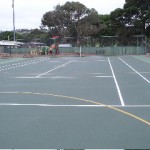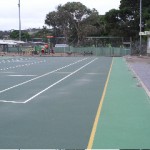[ see also: The planned destruction of Penneshaw’s Aleppo trees — QoN by Cr Liu 2013.01.16 ]
UPDATE 2013.06.10:
Dear Kangaroo Island Council (CEO and all Councillors)
Due to the inconclusive records kept on this Island in the past, it cannot be completely proved that the Aleppo pines here were planted to honour soldiers. There are many references to this being done all over rural SA – but the records for the Island on the Trove site of the National Archive and others are minimal.
However, as previously established, and in addition:
1) The seeds of deliberately planted Aleppo pines in this country came from the Lone Pine seedling tree at the War Memorial in Canberra.
2) The tree roots are not responsible for damage to the Netball Courts (trees several feet below the level of the courts – arborists confirmed that tree roots do not go up).
3) There is no justification for spending up to $6,000 plus on removing these trees when the Council is failing to maintain roads adequately – especially on the Dudley Peninsula – the notorious Cape Willoughby Road being an outstanding example.
4) There is no justification for this sort of spending when the state of the public toilets in Penneshaw is a disgrace – the toilets behind the Hall are a health hazard. Locals, tourists and Market attendees have complained for years. Nothing is done. Yet the public toilets in Kingscote are another matter entirely. Interesting.
5) The public consultation document re the trees failed to conform to the Local Government Act, Section 6(a) – namely “to act as a representative, informed and responsible decision maker in the interests of its community.” There was no proper research conducted. Accurate reports and adequate information were not provided to elected members. Most Councillors did not bother to request full research on the status of these trees after being alerted to a need for this by my submission.
No other options for the trees were considered. Daniel Rowley’s letter to the Netball Club must have had an inspection report of some kind done beforehand – now claimed not to exist. Has anyone asked Mr Rowley about this personally?
Mr Keenan’s so-called “research” was a couple of phone calls – the State RSL people I have dealt with know nothing about him consulting them. Veteran’s Affairs don’t have relevant information on this either.
The local arborist and the local RSL both requested that the trees not be removed. The quote from the arborist to remove the trees did not include the removal of stumps and roots – a much higher cost.
It is well established (see Christmas Cove and Hog Bay Road, Pelican Lagoon) that the removal of mature trees causes a mass of seedlings to grow due to the removal of the suppression factor in the mature tree. This necessitates the use of nasty chemical poisons to remove the seedlings.
The Councillors who voted to remove the trees were quite happy to empty the Penneshaw contingency fund and have no money available for any unforeseen services required in the current financial year.
6) I attach some of the photographs taken by me of the Netball Courts surface. These are particularly relevant to the claim by the Netball Club that the surface of the courts was frequently covered with needles and debris from the Aleppo pines. These photos were taken on 2 June, 2013 – the day before a very strong wind had blown all day – mostly from the SW, i.e. behind the trees and towards the courts, and yet the debris on the courts was absent – except for leaves in a small amount in the corner near the roadside which were from the plants in tubs along the road boundary.
At no time in my research period have I seen or photographed the debris claimed to be on the courts. A few small bits now and then, and that’s all.
7) I also attach a report by the NRM concerning some new and very relevant information concerning the Aleppo pines:
The yellow-tailed black cockatoos [Calyptorhynchus funereus] have recently been declared as “Vulnerable” in South Australia. I attach a report on this matter and refer you to the following site for information on the relevance of Aleppo pines to the status of these birds – pages 13 and 14 in the first section of this comprehensive report are especially relevant:
In summary – Aleppo pines were removed in the Port Lincoln area several years ago and the resident population of yellow-tailed black cockatoos crashed. They currently have only 9 birds left. The native food plants for these birds are in short supply on this Island – especially around Penneshaw. They have adapted from their native foods (Hakeas and Banksias) to rely on the highly nutritious Aleppo pine seeds as the major source of their food – both on the mainland and the Island.
Therefore, to take out any of their food source trees is plainly ill-advised to say the least. Especially as several of the mature Aleppos in Penneshaw have been butchered by ETSA pruning for power lines. All the Aleppos in the Lane are even more important as a result.
These birds could easily be pushed from “Vulnerable” to “Endangered” by lack of adequate food sources.
Does the Council want a similar situation to that of Port Lincoln? These birds are just as important to support as the glossy-black red-tailed cockatoos [Calyptorhynchus halmaturinus].
I will be making this information widely available on media sites and through other media outlets. People need to be made aware of why these trees need to remain and be conserved. The community could also plant some Hakeas and Banksias for the long term (they are very slow maturing to useful food source trees).
I suggest that a rescission motion needs to be passed to stop the removal of these trees as soon as possible.
As well as the birds, the long dead soldiers will be pleased.
Elizabeth Shearman
PO Box 247, Penneshaw, SA 5222
Tel – 08 8553 1229
******************************
Aleppo Pines – the facts.
On 12 September 2012 at the Council meeting in Penneshaw, a motion to remove 3 Aleppo Pines (Pinus halepensis) from The Lane next to the netball courts in Penneshaw was passed with little discussion.
The main reasons given for proposing this, by Councillor Joy Willson, included:
a) the roots of the trees are destroying the surface of the courts
b) the needles are falling on the courts
c) the Netball Club deserves to be looked after by Council.
Neither Darren Keenan, who was in charge of the public consultation re this matter, nor any elected member present, mentioned the major reason why this should not happen, viz. – that the Aleppo Pines were planted Australia-wide in memory of WW1 returned soldiers. Mr Keenan claimed in his report to Council that neither the RSL SA nor the Department for Veterans Affairs could confirm this fact. When I spoke to the senior managers in RSL SA in early July before researching this matter – they knew of this initiative of the RSL but were unsure of the details. They referred me to various archives both State and Federal.
The relevant date for the start of the RSL initiative in SA was reported in The Advertiser in June 1938 and Local Councils statewide were involved in supporting this from July 1938 to November 1943.
As I said in my submission to Council, the Aleppo Pine was the Lone Pine at Gallipoli. The cones/seeds were brought back by returning WW1 soldiers. The trees were first planted in Canberra,Victoria and NSW soon after and then they were planted over much of Australia (outside of the Tropics) at various times subsequent in the inter-war years. The Duke of Gloucester planted one at the National War Memorial in Canberra in October 1934 and it stands over 20 metres tall today.
The Aleppo Pine is a Mediterranean species, drought tolerant, a great shade tree, doesn’t drop limbs as is the habit of large gum trees, and doesn’t spread easily. The trees were often planted in rows. Many are near buildings and have caused no problems re roots. This is corroborated by the letter to the Netball Club by Daniel Rowley on 6 June 2008 re the problems with the netball court surface – “the major issue with the Netball Court surface is the way the underlying pavement was prepared, being to a substandard. This is magnified by the age of the court. While the trees may be having an input, this would be minor.”
This was further agreed by a letter to Council from Sam Thomas, Treasurer, Netball Club, on 28 November 2010, in which she admitted that “the cause of the drainage issues was found to be substandard work completed on the court in previous years. We have since undertaken remedial works to the value of $2739.90, as per attached invoice, to bring the court to the standard necessary for resurfacing.”
The Aleppo Pines on the Island did not float down from the ether, they were obviously deliberately planted and they are evident all over the country for the reasons stated above. There is copious evidence on the internet for them being planted to honour returned soldiers. Put in “trees servicemen memory” or “Aleppo pines honour soldiers memory” or similiar into your search engine and you’ll be reading for a long time.
These trees are ageing and will not live forever. If they are professionally trimmed on the side facing the netball court, they will not be dropping much on the surface.
As I said in my submission to Council “The destruction of these trees would therefore be an insult to the memory of our Returned Servicemen and Servicewomen.” Does our community want this?
There are many who would not want to show disrespect to our diggers of WW1 and later wars in this manner. If you are one of these – let your Council know about your sentiments.
Finally – for the purists who are anti any introduced species – they will have a very restricted diet if they don’t consume non-native plants!
Elizabeth Shearman
PO Box 247
Penneshaw
SA 5222
Tel 8553.1229



I am not from penneshaw however from an outsiders point of view I can see that there is a problem with the trees and offer a solution.
Is it possible to propagate new plants from the seeds of the existing trees? If so these could be planted in an appropriate located and given the recognition that they deserve by means of a plaque stating the history of the trees and commemorating the WW1 diggers.
If, as stated above, the existing trees won’t last forever this would be an ideal way to ensure the sacrifices our Diggers endured would not be forgotten.
Although some Aleppo pines were apparently planted as a war memorial, this is by no means the only reason they were planted and it cannot be assumed that just because they were deliberately planted they are a memorial. Aleppo pines were also widely planted as shade and windbreak trees, before people realised how invasive they could be and how difficult they could be to control as a weed. Unlike Olive trees, introduced from the same region and correspondingly invasive, they do not even produce anything edible. KI already has Aleppo weeds, and Aleppo pines that are not planted deliberately are a declared plant in SA.
It does not seem sensible to maintain a seed source on the island if there are additional management reasons to remove the trees. If, however, the trees can be pruned and managed for their natural life so as not to offend anyone’s memory this is far preferable to new (potential weed seed source) trees being planted from seeds of the existing Aleppo pines.